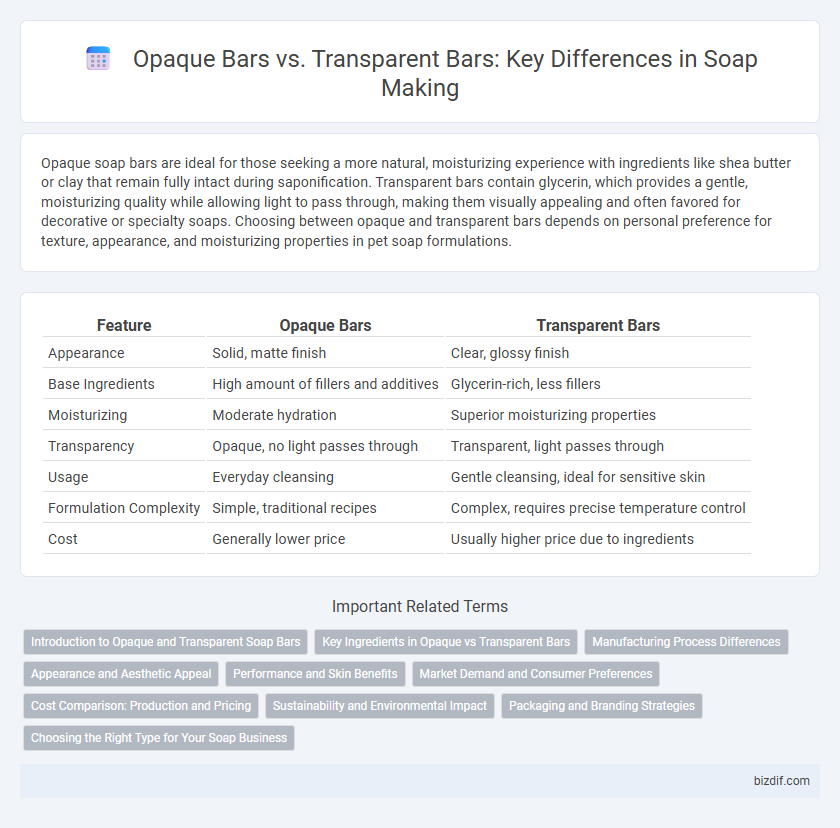Opaque soap bars are ideal for those seeking a more natural, moisturizing experience with ingredients like shea butter or clay that remain fully intact during saponification. Transparent bars contain glycerin, which provides a gentle, moisturizing quality while allowing light to pass through, making them visually appealing and often favored for decorative or specialty soaps. Choosing between opaque and transparent bars depends on personal preference for texture, appearance, and moisturizing properties in pet soap formulations.
Table of Comparison
| Feature | Opaque Bars | Transparent Bars |
|---|---|---|
| Appearance | Solid, matte finish | Clear, glossy finish |
| Base Ingredients | High amount of fillers and additives | Glycerin-rich, less fillers |
| Moisturizing | Moderate hydration | Superior moisturizing properties |
| Transparency | Opaque, no light passes through | Transparent, light passes through |
| Usage | Everyday cleansing | Gentle cleansing, ideal for sensitive skin |
| Formulation Complexity | Simple, traditional recipes | Complex, requires precise temperature control |
| Cost | Generally lower price | Usually higher price due to ingredients |
Introduction to Opaque and Transparent Soap Bars
Opaque soap bars contain additives such as titanium dioxide or moisturizers that scatter light, creating a creamy and solid appearance. Transparent soap bars rely on glycerin and alcohol to allow light to pass through, resulting in a clear, glass-like finish. The choice between opaque and transparent soaps affects not only aesthetics but also the formulation and skin feel.
Key Ingredients in Opaque vs Transparent Bars
Opaque soap bars primarily rely on titanium dioxide and zinc oxide as key ingredients to scatter light and create their characteristic solid, non-translucent appearance. Transparent bars incorporate high levels of glycerin, sugar, and alcohol, which control crystallization and allow light to pass through, resulting in clarity and translucency. Understanding these ingredient differences is crucial for soap makers aiming to achieve specific visual and textural properties in their bars.
Manufacturing Process Differences
Opaque soap bars are created through the hot process or cold process methods, where oils and lye saponify fully, trapping air bubbles and other impurities that cause the solid, cloudy appearance. Transparent soap bars require a more refined manufacturing process involving the addition of solvents like glycerin, alcohol, or sugar, which dissolve the soap crystals to create clarity. The precise temperature control and slower curing times in transparent soap making differentiate it from the quicker, more straightforward production of opaque bars.
Appearance and Aesthetic Appeal
Opaque soap bars display a solid, creamy texture with rich, vivid colors that add a classic and artisanal look, enhancing visual appeal on bathroom shelves. Transparent bars showcase a clear, glass-like appearance with a smooth, glossy finish that highlights embedded decorative elements and ingredients, creating a luxurious and modern aesthetic. Consumers often choose opaque bars for a traditional, handcrafted vibe, while transparent bars attract those seeking elegance and uniqueness in soap presentation.
Performance and Skin Benefits
Opaque soap bars, typically made with higher amounts of stearic acid and additives like titanium dioxide, offer excellent cleansing and moisturizing properties, making them ideal for dry or sensitive skin. Transparent bars, formulated with glycerin and lower stearic acid, provide a gentler cleanse with increased humectant qualities that help retain skin moisture and promote a smooth texture. Both types deliver effective skin benefits, but opaque bars tend to produce a firmer lather and longer-lasting bar, while transparent bars excel in hydration and visual appeal.
Market Demand and Consumer Preferences
Opaque soap bars dominate the market due to their strong moisturizing properties and ability to incorporate natural additives like shea butter, appealing to consumers seeking gentle, nourishing skincare. Transparent soap bars attract niche buyers with preferences for aesthetic appeal and ingredient transparency, often favored in luxury and artisanal segments. Market trends indicate rising demand for opaque bars in mass retail, while transparent bars maintain steady growth driven by health-conscious and eco-friendly consumer groups.
Cost Comparison: Production and Pricing
Opaque soap bars typically incur lower production costs due to simpler formulas that rely on insoluble additives like titanium dioxide and clays, reducing the need for expensive solvents or precise temperature control. Transparent bars demand higher costs in raw materials such as sugar, glycerin, and specialized solvents to achieve clarity, along with energy-intensive processing techniques like careful heating and cooling regimes. Consequently, transparent soaps are often priced higher in the market, reflecting their intricate manufacturing process and premium ingredient requirements compared to more economically produced opaque bars.
Sustainability and Environmental Impact
Opaque soap bars often utilize natural fats and oils with minimal processing, resulting in biodegradable products that reduce environmental pollution. Transparent soap bars require higher amounts of solvents and synthetic additives, increasing energy consumption and chemical waste during manufacturing. Choosing opaque bars supports sustainability by lowering ecological footprints through simpler, eco-friendly ingredients and production methods.
Packaging and Branding Strategies
Opaque soap bars offer greater flexibility in packaging design, allowing brands to use vibrant colors and bold graphics that stand out on shelves to reinforce brand identity. Transparent bars often require minimalist packaging to showcase their clarity, which brands leverage to emphasize purity and natural ingredients, appealing to eco-conscious consumers. Strategic branding for opaque bars centers on creative visual storytelling, while transparent bars capitalize on the product's intrinsic aesthetic to build trust and authenticity.
Choosing the Right Type for Your Soap Business
Opaque soap bars provide excellent customization options with vibrant colors and scents, making them ideal for businesses targeting niche markets or unique branding. Transparent soap bars offer a clear, polished appearance that conveys purity and luxury, appealing to customers who prefer minimalist or sophisticated products. Consider your target audience preferences and brand identity when choosing between opaque and transparent bars to maximize customer satisfaction and sales.
Opaque Bars vs Transparent Bars Infographic

 bizdif.com
bizdif.com